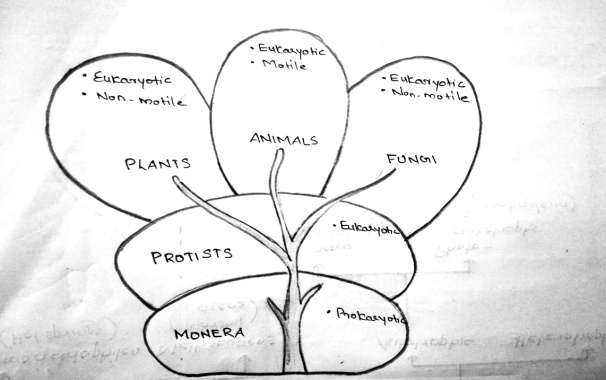Classification is the process of process of grouping organisms into different categories based on easily observable characters. The earliest classification was done by Aristotle. He used simple morphological characters to classify organisms. He grouped plants into trees, shrubs and herbs. Animals were divided into two groups, animals which have blood and do not have blood.
Linnaeus classified the living organisms into two groups – Kingdom Animalia and Kingdom Plantae. This system is known as Two – Kingdom classification. However, this system could not distinguish eukaryotes from prokaryotes, unicellular organisms from multicellular; and photosynthetic algae from non- photosynthetic algae. Hence, this classification was less accepted.
The most accepted classification system is the Five Kingdom classification proposed by R. H. Whittaker in 1969. He added three more kingdoms. Thus the five kingdoms are Monera, Protista, Fungi, Plantae and Animalia. The classification was mainly based on five different characters.
- Cell type: Kingdom Monera includes prokaryotes. All other kingdoms had eukaryotic organisms.
- Cell wall: Cell wall is absent in Animalia and in some members of Protista. Monera had non-cellulosoic cell wall. Fungi had chitinous cell wall. Plantae had cellulosic cell wall.
- Nuclear membrane: It is present in all kingdoms except Monera.
- Body organization: Monera and Protista had cellular organization. All other kingdoms had multicellular organization.
- Mode of Nutrition: Kingdom Monera, and Protista are autotrophic as well as heterotrophic. Plantae are completely autotrophic. Fungi and Animaliae are heterotrophic.
Other famous classification systems are – Three domain system, six kingdom system and Eight kingdom system.
Eu – bacteria
Archae -bacteria
Three domain
E U K A R Y A
System
Five kingdom
Monera
Animalia
Fungi
Plantae
Protista
Classification.
Archae -bacteria
Plantae
Protista
Animalia
Eu – bacteria
Six Kingdom
Fungi
Classification
Archae -bacteria
Eu – bacteria
Animalia
Fungi
Eight Kingdom
Plantae
Classification
Chromista
Protista
Archezoa
Five Kingdom Classification
In the Five Kingdom Classification, all prokaryotic organisms were brought together to form the Kingdom Monera.
All unicellular eukaryotic organisms were grouped into Kingdom Protista. By creating this group, Whittaker was able to bring many unicellular organisms which were earlier added in Plantae and Animalia kingdoms.
Most scientists prefer to divide Kingdom Monera into two groups: Eubacteria and Archaebacteria for the convenience in classification. Hence, a Six – Kingdom classification is more prevalent in taxonomy.
